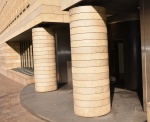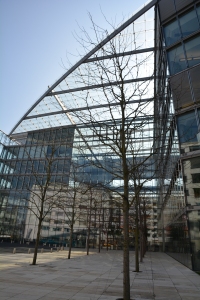Geneva is not especially known for its modern architecture. Most new arrivals in the city head for the old town on the hill and its medieval and Renaissance buildings when they want to see Geneva’s attractions. But there are three modern buildings that belong to the best of Geneva’s built environment that I would like to share with you. Two are in the Eaux-Vives section of town and one in the former industrial area of Sécheron. They are:
- Immeuble Clarté by Le Corbusier
- Julius Bär bank by Mario Botta
- Merck/Serono building by Helmut Jahn
Immeuble Clarté
Le Corbusier (1887-1965 ) is one of the most famous and influential architects of the 20th century. He was born Charles-Édouard Jeanneret in La Chaux-de-Fonds in the canton of Neuchatel and took the name of Le Corbusier in the 1920’s when it was fashionable for artists and architects to have only one name. He was a pioneer of modernist architecture, which is characterized by simple forms and an absence of applied decoration.
 “Immeuble Clarté”, also known as “Maison de Verre” (glass house), at 2-4 rue Saint-Laurent in the Eaux-Vives, is an apartment building Le Corbusier designed in collaboration with his cousin, Pierre Jeanneret, with whom he worked for many years. The construction was completed in 1932 and was highly innovative for the time. The framework is entirely of metal and large panes of glass are used on the exterior. The apartments are of various sizes with open plan living spaces and Le
“Immeuble Clarté”, also known as “Maison de Verre” (glass house), at 2-4 rue Saint-Laurent in the Eaux-Vives, is an apartment building Le Corbusier designed in collaboration with his cousin, Pierre Jeanneret, with whom he worked for many years. The construction was completed in 1932 and was highly innovative for the time. The framework is entirely of metal and large panes of glass are used on the exterior. The apartments are of various sizes with open plan living spaces and Le  Corbusier experimented by including several duplexes. He designed not only the structure but everything in the interior as well, from the door handles to the bathroom fixtures. The building is high maintenance and has been renovated several times, the last renovation in 2007-09 financed by Geneva and the Confederation. Since it is one of only two building s by Le Corbusier in Switzerland, it is considered to be an important piece of Switzerland’s architectural heritage. A request for it to be named a world heritage building has been submitted to UNESCO.
Corbusier experimented by including several duplexes. He designed not only the structure but everything in the interior as well, from the door handles to the bathroom fixtures. The building is high maintenance and has been renovated several times, the last renovation in 2007-09 financed by Geneva and the Confederation. Since it is one of only two building s by Le Corbusier in Switzerland, it is considered to be an important piece of Switzerland’s architectural heritage. A request for it to be named a world heritage building has been submitted to UNESCO.
Julius Bär bank
The Julius Bär bank was designed by Mario Botta (b. 1943), an internationally renowned Swiss architect from Ticino. Botta is mainly known for using relatively inexpensive traditional materials, such as bricks, and simple geometric forms, like circles, squares and rectangles, in multiple combinations. Many of his buildings can be found in Switzerland but also in the USA, other European countries and the Middle East. One of the best known is the Museum of Modern Art in San Francisco (1995). Geneva is lucky to have two Botta buildings, the other being the Museum of the Martin Bodmer Foundation in Cologny.
 Dating from 1987, the Julius Bär building is located at 30 avenue de Frontenex in a commercial section of the Eaux-Vives not very far from Immeuble Clarté. It
Dating from 1987, the Julius Bär building is located at 30 avenue de Frontenex in a commercial section of the Eaux-Vives not very far from Immeuble Clarté. It  stands out from the others because of its yellow color and elegant structure. Botta used his signature honey colored stone from Italy to coat the outside. The front of the building is divided into two huge towers with large square openings at the bottom and the top. The rest of the building seems to be turned inward, but the narrow deeply-set windows and a glass roof allow natural light to illuminate the interior. The long body of the building fits compactly into the city blocks surrounding it demonstrating an ingenious use of the restricted space.
stands out from the others because of its yellow color and elegant structure. Botta used his signature honey colored stone from Italy to coat the outside. The front of the building is divided into two huge towers with large square openings at the bottom and the top. The rest of the building seems to be turned inward, but the narrow deeply-set windows and a glass roof allow natural light to illuminate the interior. The long body of the building fits compactly into the city blocks surrounding it demonstrating an ingenious use of the restricted space.
The Merck-Serono building
 The most recent of the three buildings is the Merck Serono glass palace designed by Helmut Jahn of the Chicago firm, Murphy /Jahn. Jahn (b. 1940) is a German-American architect famous for his many spectacular glass structures, such as the Sony Centre in Berlin. The Merck/Serono building was conceived as the
The most recent of the three buildings is the Merck Serono glass palace designed by Helmut Jahn of the Chicago firm, Murphy /Jahn. Jahn (b. 1940) is a German-American architect famous for his many spectacular glass structures, such as the Sony Centre in Berlin. The Merck/Serono building was conceived as the  headquarters of the biotechnology firm, Merck-Serono, and completed in 2007 at a cost of $1.25 billion. The stunning transparent building is located at 9 chemin des Mines in Geneva’s former industrial site of Sécheron and was designed to house laboratories, offices and a series of community spaces. A glass building skin covers the entire steel structure which was intended to give the building its dramatic appearance but also to provide the occupants with daylight and views of the exterior. From a spacious plaza in front of the building, the entrance leads into a high atrium from which a network of glass-and-steel bridges connecting the upper levels can be seen. A multimedia installation incorporating a water wall occupies one elevation. The wall acts as a humidification device in the winter and allows for cooling in the summer. Other energy saving mechanisms include a thermal
headquarters of the biotechnology firm, Merck-Serono, and completed in 2007 at a cost of $1.25 billion. The stunning transparent building is located at 9 chemin des Mines in Geneva’s former industrial site of Sécheron and was designed to house laboratories, offices and a series of community spaces. A glass building skin covers the entire steel structure which was intended to give the building its dramatic appearance but also to provide the occupants with daylight and views of the exterior. From a spacious plaza in front of the building, the entrance leads into a high atrium from which a network of glass-and-steel bridges connecting the upper levels can be seen. A multimedia installation incorporating a water wall occupies one elevation. The wall acts as a humidification device in the winter and allows for cooling in the summer. Other energy saving mechanisms include a thermal  exchange system that relies on water pumped from Lake Geneva and provides 70 percent of the energy that the building requires for heating and cooling. Another technical wonder is a retractable roof over the forum in the centre of the building which can be opened in the summer and is supposedly the largest of its kind in the world.
exchange system that relies on water pumped from Lake Geneva and provides 70 percent of the energy that the building requires for heating and cooling. Another technical wonder is a retractable roof over the forum in the centre of the building which can be opened in the summer and is supposedly the largest of its kind in the world.
Unfortunately, five years after the completion of the building Merck announced the closing of its Geneva headquarters and since then much effort has been made to find employment for its staff and various plans formulated for the use of the building. Hopefully, one of the most original buildings in Geneva will soon find an occupant.
We are a group of international women living in Geneva, Switzerland. If you would like to join the AIWC, please visit our website at http://www.aiwcgeneva.org/.


Pingback: Geneva, part 4….Ginebra, parte 4 | cfotofan
Pingback: living architecture - The Tech
Pingback: Architecture Geneva In Modern | Become Architecture Fan
Thanks for this great post. I visited Immeuble Clarté and the Julius Baer Bank by Mario Botta. I can’t see previous comments, but if no one has just wanted to note that the address given is for other JB Bank buildings, and the address of the Botta one is Avenue de Frontenex 30, 1211 Geneve 3
Thank you for your correction! I will pass your comment on to our author, katalinh2012, so she fix this error.
thanks for this post. I reproduced part of it in my blog : http://www.carolinanegel.com/blog365
Carolina, you’ve got fabulous photos of Geneva. Many I recognize, some I don’t (#54 Industrial Sight).